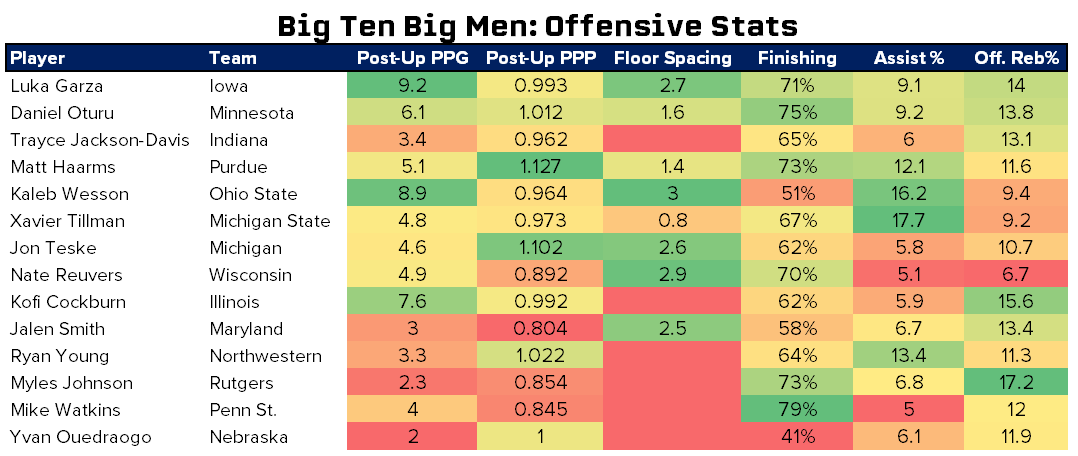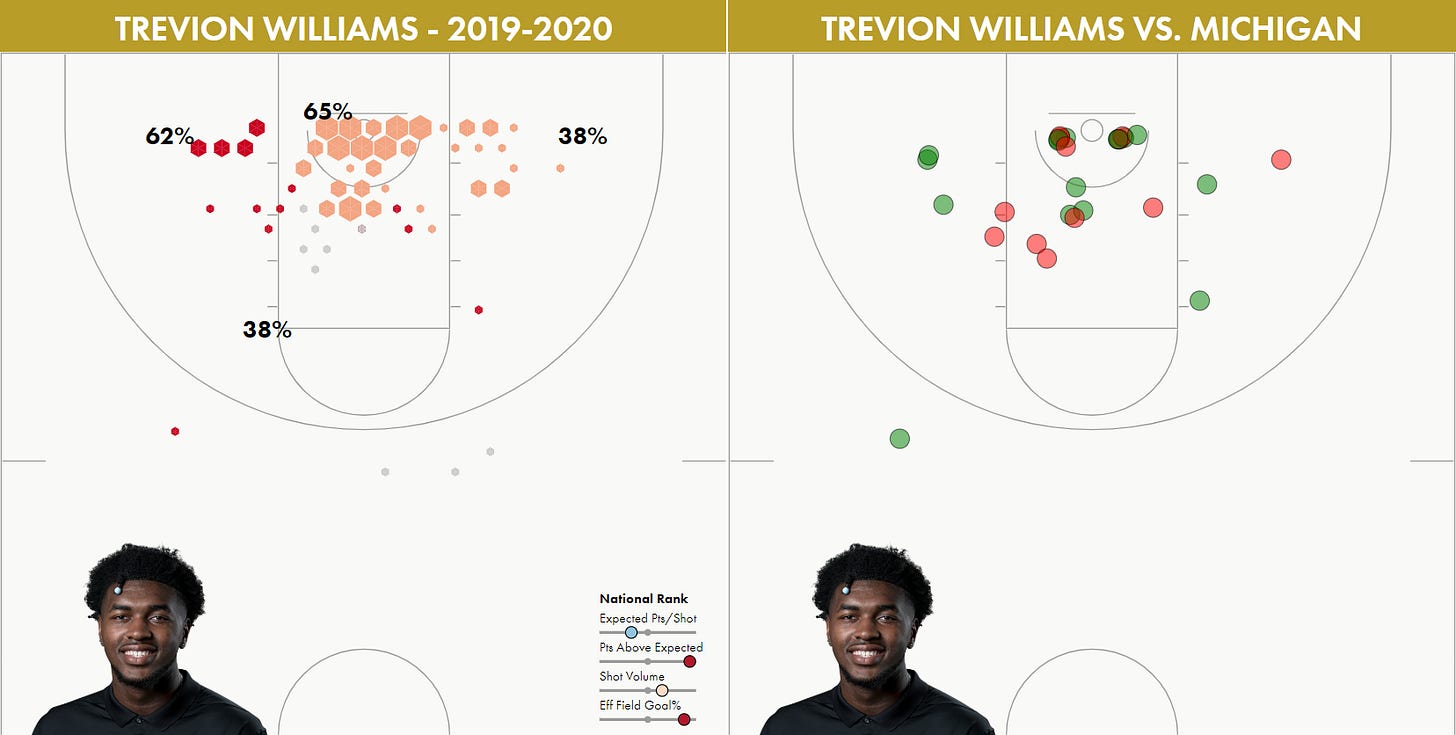The 2019-20 Big Ten Player of the Year is most likely going to be a point guard who wears a green and white No. 5 jersey, but the quality of big men in the conference sets the league apart.
I set out to pull some statistics about Luka Garza and Daniel Oturu but was quickly reminded of just how many elite bigs there are in the conference.
There are so many great interior players, and it is an almost impossible task to sort through them. Given their unique skillsets, I’m not sure that many coaches in the league would even consider trading their starting center for another team’s.
I decided to take a shot at ranking the group, mostly to provide a framework to analyze the group and point out some of the differences between the league’s bigs.
To provide a framework, I pulled a handful of different statistics and used them to evaluate one big man from each league team. Those stats were:
Offensive rating; usage rate; minutes percentage; post-up points per game; post-up points per play; floor spacing (catch and shoot points per game); FG% inside of five-feet; assist rate; offensive rebounding rate; team FG% allowed inside of five-feet; block percentage; defensive versatility (an arbitrary ranking); defensive rebounding rate.
From there, I blended the stats to give each player a basic offensive and defensive score. The process isn’t exact or scientific, but it served as a decent representation of strengths and weaknesses.

Judging by that chart, there are two apparent outliers and a notable crop of big men who are gathered somewhere in the middle of the pack.
1. Daniel Oturu, Minnesota
Oturu pops as the most reliable two-way big man in the conference. He's an efficient, high-usage offensive player with a developing ability to stretch the floor. He's a good rebounder, and Minnesota's interior defense has been solid this year.
His shot chart shows how effectively he finishes inside, but also that he’s comfortable knocking down jumpers in the middle of the floor.

2. Xavier Tillman, Michigan State
Tillman isn’t the most dominant post-up scorer or shot-blocker in the league. He’s not a great shooter, and he’s ranked second-to-last among this group in offensive rebounding. He’s not the highest-usage or most efficient offensive player, either.

But Tillman stands out because he checks every box. He can score in the post, hit the occasional jumper, and change the game with is defense. If you need him to defend Luka Garza, he’s your guy. If you need him to switch onto Zavier Simpson, he’ll do that too.
The other statistic that sets Tillman apart is his passing. Tillman’s 17.7% assist rate leads this group and is an added wrinkle to his game as a junior. Since an opening loss to Kentucky, Tillman has recorded at least two assists in every Michigan State game.
Does Tillman benefit from playing with the best point guard in the country? Probably, but Michigan State isn’t Michigan State without Tillman. Per Hoop Lens, the Spartans are 41 points per 100 possessions better with Tillman on the floor.

3. Luka Garza, Iowa
Garza is the best offensive big in the Big Ten. He can play with his back to the basket, hit jump shots, finishes better than 70% of his shots around the rim, and is a force on the offensive glass. He's not averaging 22 points and 11 rebounds per game by accident.
His overall offense numbers are in a different stratosphere than the rest of the league.

Garza is ranked 12th nationally with 9.2 points per game created out of post-ups, which leads the Big Ten.
But how do you adjust for with his defense? Iowa is allowing a league-worst 60% shooting around the basket, and much of that falls on Garza’s shoulders. Other big men in the conference defend at an elite level, and Garza doesn’t.
4. Kaleb Wesson, Ohio State
Wesson’s ability to score with his back to the basket is on par with Garza, but he is an even better floor spacer and passer.
Here’s a plot of the Big Ten’s primary post-up scoring threats against the rest of the country that helps illustrate how productive Wesson has been this season.

Wesson’s most significant issue is that he doesn’t finish as efficiently around the basket as several other bigs on this list. Of the 14 bigs included, Wesson’s 51% shooting around the basket is second worst.

5. Jalen Smith, Maryland
Smith has as much raw talent as any interior player in the league, but I’m not sure what his offensive identity is. He’s not a back-to-the-basket scorer, and jump shooting is something he does but not his foundation. Right now, he’s still at his best as an energy guy and finisher around the rim.

6. Jon Teske, Michigan
Jon Teske has added a post-up element to his game this year — he’s the second most-efficient post-up scorer in this group on average usage — but his offensive game starts with his ball screen usage.
Teske is one of the most productive roll men in the country and one of just two players in college basketball to average over four roll-man plays per game.

7. Nate Reuvers, Wisconsin
Reuvers’ spike in usage from 19.8% as a sophomore to 27% as a junior is one of the largest in the conference. He’s become a more efficient offensive player inside the arc — 55%, up from 49% as a sophomore — but his 3-point shooting has slumped a bit.

8. Kofi Cockburn, Illinois
I didn’t expect Cockburn to end up this far down the list, but he doesn’t jump in any particular area. He’s one of the better one-on-one scorers in the post, a look that Illinois relies on, but he doesn’t pass the ball from the block as effectively as Wesson or even Garza.
He still feels undervalued on this list given the impact that he’s had on Brad Underwood’s team this year. Cockburn’s presence has allowed the Illini to become a dominant offensive rebounding team and shore up the interior defense.
9. Trayce Jackson-Davis, Indiana
Jackson-Davis is the most efficient big man in the country, but he’s only using 21.7% of Indiana’s possessions while on the floor. That pales in comparison to some of the bigs at the top of this list who are routinely using 25+%.
Jackson-Davis’ efficiency is a product of an efficient offensive blend. He only uses 19% of his offensive possessions on post-ups, per Synergy, less than he scores on cuts and putbacks.

10. Mike Watkins, Penn State
Watkins is one of the best traditional rim protectors in the league. He leads the league in block rate, and Penn State only allows 47% shooting around the rim. Overall, he stands out across the board in defensive metrics.

He’s more limited offensively with just average efficiency as a post-up scorer and plays fewer minutes than most of the other primary names on this list.
11. Matt Haarms & Trevion Williams, Purdue
I wrote most of this update before Matt Haarms got hurt, and Trevion Williams went for 36 points and 20 rebounds on Thursday night.
Given that monster night, it makes sense to show a little love to Williams. Most of his damage came around the rim, but Williams made six shots outside the paint including a desperation three. Before Thursday, he had only made nine made field goals outside the paint all season.

The two bigs are in a timeshare, which makes it hard to figure out how to rank them in a league where players like Oturu, Tillman, and Garza play 75% of available minutes regularly.
12. Myles Johnson, Rutgers
Rutgers is 3-1 and has the best defensive rebounding team in conference play. Myles Johnson is a big reason why. He’s not as dynamic as many of the other bigs in the conference, but he’s an elite finisher, rebounder, and defender that fits Steve Pikiell’s mold.
13. Ryan Young, Northwestern
Young is Northwestern’s most efficient offensive player with a 117.8 offensive rating, but he’s been a defensive liability, and his finishing has fallen off a cliff in league play.
Young shot 68% on twos in non-conference play compared to just 46% in Big Ten games.
14. Yvan Ouedraogo, Nebraska
Fred Hoiberg’s team is ranked 348th nationally in defensive rebounding. He’s asking for a lot from two freshmen bigs.


